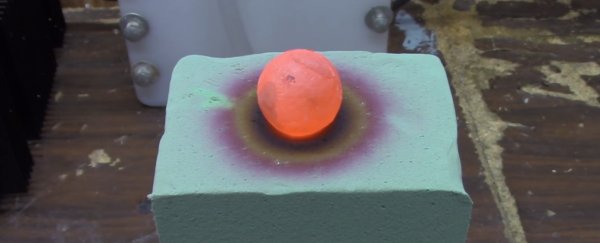If you're a regular science YouTube lurker, you've probably seen user carsandwater's red-hot nickel ball experiments before. The premise is pretty simple: you heat up a solid ball of nickel until it's red-hot, and then sit it on top of different types of material to see what happens. So far we've seen the red-hot nickel ball vs. Gak, a jawbreaker, and the only thing it hasn't managed to destroy, a hockey puck. But in this episode, the scorching ball of metal is put to the test against innocuous-looking floral foam, which is used by florists to hold arrangements together, and the reaction is not at all what we expected. In fact, we'd go so far as saying it's the best one yet.
As you can see above, for once, the red-hot nickel ball doesn't melt a hole in the foam or burn through it… it actually seems to suck the life right out of it, kind of like a Harry Potter-style Dementor. The whole thing starts slowly enough, with the heat spreading from the ball through the floral foam in a ring of dark purple, then green, and then black. As it travels across the top of the block of foam, carsandwater (real name: Matthew Neuland) speeds up the footage, and shows it turn the whole thing to charcoal.
This is time-lapse footage, so it all happens a lot quicker than it would in real life, but seeing the heat spread through the material in a melancholic rainbow of colours is pretty damn incredible. And when the footage comes back to real time, you can see that even when the top of the foam is desiccated and charred, the bottom is still glowing with heat.
So what's going on here? Floral foam is what's known as a thermoset phenolic foam, and is made by cross-linking the carbolic acid phenol with formaldehyde. This gives the material phenomenal heat resistance, and means that it will soften when heated, but it won't melt, as the Engineer's Handbook explains. This is why phenolic resins are used to build spacecraft reentry shields and cookware.
But while it makes sense that the floral foam doesn't melt because of its chemical composition, why exactly does it turn it into the black chunk that Neuland shatters at the end of the experiment? The foam is a type of synthetic carbon, which means it's so dense, it doesn't allow for air-flow. Because of this, the heat smoulders through the material, rather than forming a proper flame, sucking the oxygen out as it goes, and leaving behind the dried out remains. This is the same reaction that happens when you turn wood into charcoal.
Check out the video above to marvel at science in action. And remember, don't try this at home.
